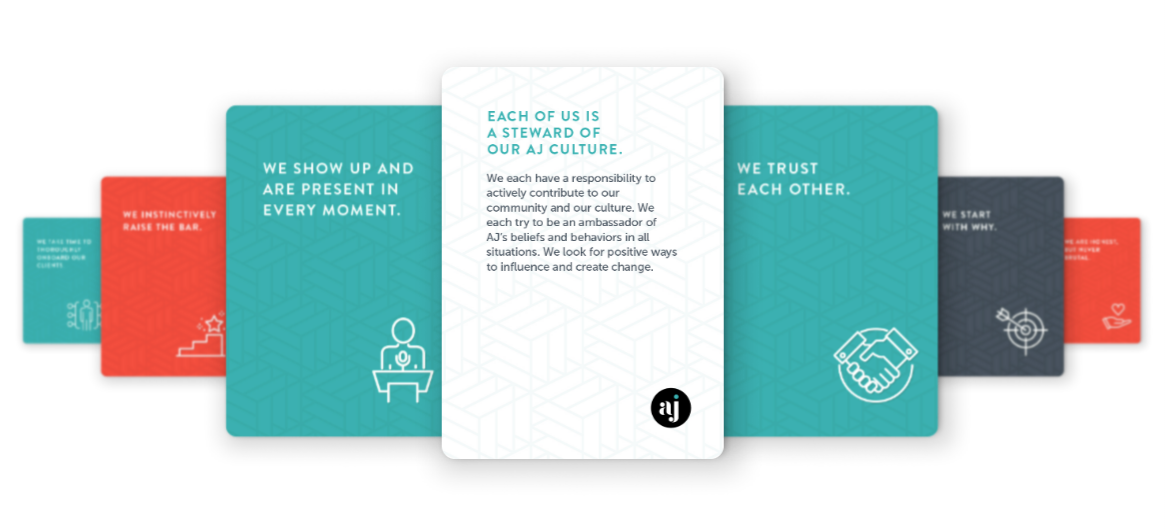Event Branding: Craft Engaging Experiences with the C.R.E.A.T.E Framework
Imagine entering a room where the atmosphere is electric, the environment immersive, and every detail meticulously tailored to create a lasting...

By August Jackson
When it comes to external perception, a company’s brand is often its biggest asset. A clear, decisive, and memorable brand can make or break public interest and engagement. But branding is never just an external exercise, and as more and more organizations turn their attention to issues of employee retention, engagement, and well-being, it’s clear that a company’s brand can be its defining internal guidepost as well.
As we all adapt to the shifting realities of today’s workforce, let’s talk about how to think outside, in, and turn your great company brand into a great employer brand.
An employer branding strategy is the comprehensive process of positioning your company as an employer of choice among your target audience – the ideal employees. By promoting your organization's unique benefits, culture, and career opportunities, you can attract, engage, and retain top talent in a competitive job market.
A successful employer branding strategy involves defining your Employer Value Proposition (EVP), creating a consistent brand message, leveraging employee advocacy, and monitoring and measuring your employer brand's performance.
In today's job market, a strong employer branding strategy is crucial. According to recent research, 72% of recruiting leaders believe that the employer brand affects the hiring of the company. Moreover, 59% of employers think that employer branding is the key to their HR strategy.
Investing in an employer branding strategy offers numerous benefits that impact the overall success of your organization:
Showcasing an organization's unique culture, values, and employee experience, a strong employer brand can help companies outshine their competitors. Here's a step-by-step guide to building an effective employer branding strategy:
Identify what makes your company an attractive place to work. Think about factors like culture, benefits, work environment, career development, and company reputation. Crafting a clear and concise EVP that reflects your organization's strengths and resonates with your target talent helps set the foundation for a strong employer branding strategy.
Understand your target audience by exploring their needs, preferences, and expectations. Use surveys, focus groups, and interviews to gather insights from current and former employees, as well as candidates who declined job offers. Analyze industry trends and study your competitors' employer branding strategies to pinpoint gaps and opportunities.
Develop a captivating narrative that highlights your EVP and aligns with your organization's mission, vision, and values. This narrative should be authentic, consistent, and inspire trust. Use storytelling to showcase real-life employee experiences, emphasizing what makes your company a fantastic place to work.
Encourage your employees to become brand ambassadors by promoting the company's culture and values. Implement initiatives that reinforce your EVP, such as employee recognition programs, training and development opportunities, and team-building events. Foster open communication and involve employees in decision-making processes to ensure they feel valued and engaged.
Make sure your company's career site and social media channels reflect your employer brand narrative. Share content that highlights your EVP, like employee testimonials, behind-the-scenes insights, and company news. Optimize your job postings to be engaging and informative, and use search engine optimization (SEO) techniques to boost visibility.
Utilize platforms like LinkedIn, Facebook, and Twitter to engage with potential candidates and showcase your employer brand. Develop a content strategy that combines informative, engaging, and shareable content. Encourage your employees to share their experiences and interact with potential candidates online. Roughly 68 % of talent acquisition leaders agree that social professional networks is one of the most effective tools for spreading awareness about employer brand
Establish key performance indicators (KPIs) to track the success of your employer branding efforts. These might include metrics like time-to-hire, cost-per-hire, employee turnover, and candidate quality. Regularly assess your employer branding strategy and adjust it as needed based on the data and feedback you receive.
As your organization evolves, so should your employer branding strategy. Stay up to date with industry trends, benchmark your efforts against competitors, and seek feedback from employees and candidates. Regularly evaluate and refine your strategy to ensure it remains relevant and effective.
As you embark on building a robust employer branding strategy, it's important to remember that your employees are the key to bringing your brand to life. By putting their well-being, happiness, and work-life balance at the forefront of your efforts, you'll be able to create an organization that not only attracts top talent but also fosters a thriving community of engaged and committed professionals.
Now that we've laid the groundwork for a successful employer branding strategy, let's explore how to walk the talk and support your most vital stakeholders—your employees.

One way August Jackson emphasizes our employer brand is through our principle cards. AJ Principles articulate what we believe in and how we work together. They set the bar for what good looks like at our agency. Our principles are the compass for making the right decisions, working through challenges, and celebrating our achievements.
Today’s employees and job seekers want to work for authentic organizations that do more than talk the talk. They’re looking for opportunities to plug-in to professional communities that perform with purpose and make a real difference… not just for clients or customers, but for their own families and personal lives, too.
Every day, you ask your employees to show up in a way that supports your company’s culture and productivity—in a way that aligns with your company’s brand. You can meet them halfway with an employer brand that welcomes them, supports their job satisfaction, and strengthens their sense of belonging.
Check out the four key ideas below to create an employer branding strategy that puts your employees first.
In a culture almost universally prone to burnout and overwork, show your employees you care about more than just their contributions to the company by proactively and intentionally promoting their well-being.
While recognizing excellent job performance with job-focused rewards—bonuses, advancement, public recognition, etc.—is awesome, it can easily become transactional. In line with a commitment to your employees’ overarching well-being, level-up your employee recognition efforts by adding to the “life” side of their work-life balance. Consider:
In all of these examples, think not only about what your organization values, but about what it’s people value. Find ways to make employees feel seen professionally and personally through your recognition efforts.
When you’re hoping to increase retention and support talent acquisition, one of the easiest ways you can help promote employee engagement is by making sure your employees have a real understanding of the organization, community, and purpose they’re a part of. This means:
People who truly feel they understand their company’s mission and impact are more apt to feel they understand their own professional impact. Most importantly, they’re that much more likely to stay engaged as a result.
Brands define how a company looks, feels, and acts. Look for unique opportunities to make a statement about your brand specifically for the enjoyment and support of your employees. Consider weaving the following into your employer branding strategy:
No matter what your organization does, or how many people you employ, a strong employer branding strategy can be the difference that helps you fill open positions within your company and keep fantastic people working in and for your business for the long haul.
By investing in a comprehensive employer branding strategy and continuously refining your approach, you'll create a thriving workplace that attracts, engages, and retains top talent.
At August Jackson, we partner with leaders to help them understand the real power of their brand, embody that brand at every level of their company, and engage with their employees, their customers, and the public.
Together, we can unlock your organization's full potential and set you on a path to long-term success. Come get creative with us!

